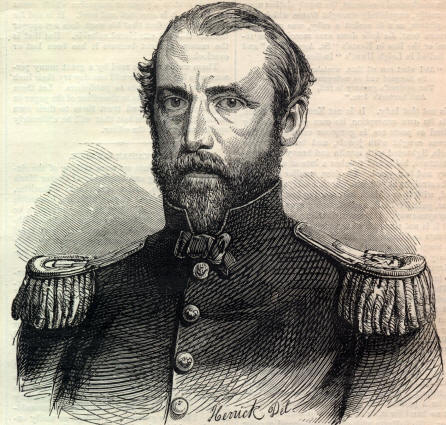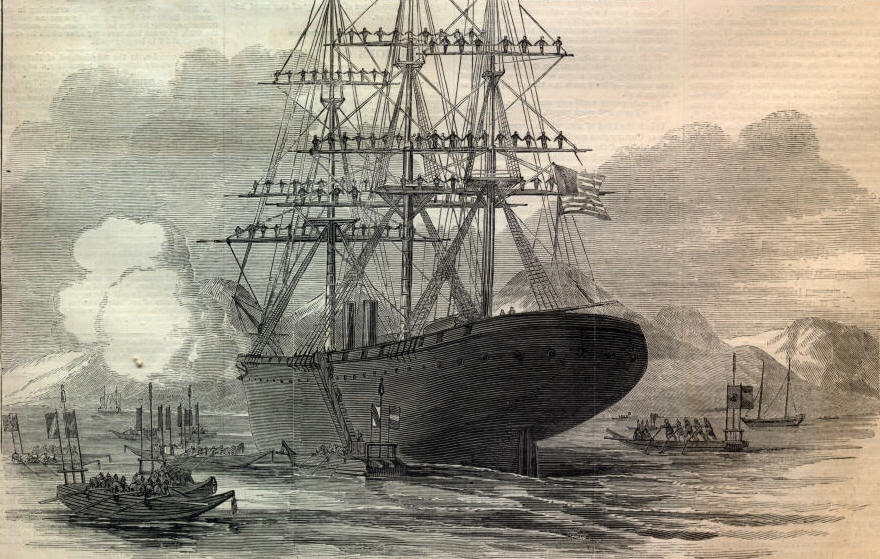Captain Foster News Article
|
|
This Site:
|
Biography and Portrait of Captain Foster in Harper's Weekly Civil War NewspaperThe February 9, 1861 Edition of Harper's Weekly
We acquired this leaf for the purpose of digitally preserving it for your research and enjoyment. If you would like to acquire the original 140+ year old Harper's Weekly leaf we used to create this page, it is available for a price of $150. Your purchase allows us to continue to archive more original material. For more information, contact paul@sonofthesouth.net <
HARPER'S WEEKLY.[FEBRUARY 9, 1861. 84 CAPTAIN J. G. FOSTER, ENGINEER CORPS U.S.A., ON DUTY AT FORT SUMTER.ON THE LADIES' POND. LIKE swallows darting through the sky, Now here, now there, now far beyond, Before the following wind we fly, And skim along the Ladies' Pond. Bright arabesques of eyes and hair Around us ever changing wheel, And the ice glitters every where With fairy feet and twinkling steel. From fur-caps, where rich tassels sweep, And hoods with fluttering ribbons dressed, Bright, glowing girlish faces peep Like robin redbreasts from a nest. And all is gayety and mirth The women's laughter sounds like song , And I'm the happiest man on earth As side by side we sweep along. One small hand to my shoulder clings, My arm around her waist I fold ; The friendly wind that follows flings Across my cheek her curls of gold. I see my rival by the gate He follows us with sullen eye , I care not for his futile hate, I do not heed his scowl—not I. For not an hour ago I heard One sweet, sweet word, and felt a hand That, timid as a little bird, Crept into mine—you understand. So let him scowl—I do not mind ; I'm far too happy now to hate. Come, dearest, on before the wind, And leave him standing by the gate. CAPTAIN FOSTER, U.S.A.WE give above, from a photograph, a portrait of Captain JOHN G. FOSTER, United States Army, second in command at FORT SUMTER, Charleston, South Carolina. The family of JOHN G. FOSTER has ever been distinguished for its patriotism and valor. His grandfather, in company with the gallant Benjamin Pierce (father of ex-President Pierce), then quite young, was among the first to join the Massachusetts line in the War of the Revolution, and was often commended for his noble conduct on the field of battle. His father, Major Perley Foster, was in active service during the war of 1812, and was in the battle of Plattsburg, on Lake Champlain. The subject of our sketch was born in Whitefield, New Hampshire, May 27, 1823, from which place his family moved to Nashua when he was eight years of age. He early evinced a passionate love for the profession of arms, and formed and commanded a "juvenile artillery company." In 1842 he entered West Point, where he graduated with distinguished honors in his class, in 1846, as Brevet Second Lieutenant in the Corps of Engineers. In January, 1847, he was ordered to Mexico, with General Scott, as a Lieutenant in a Company of Sappers and Miners, and was in all the engagements from " Vera Cruz" to "Moline del Rey." At the latter place he was severely wounded while leading a division of the storming party in the deadly assault on " Casa Mata," where two-thirds of the entire command were cut down, and where he narrowly escaped death from the Mexican bayonet, by the memorable charge of the gallant Cadwalader. For his gallant conduct in Mexico he received three brevets—the first at Contreras, the second at Churubusco, and the last at Moline del Rey, where he was breveted as captain. The severity of his wound was such that amputation was thought to be necessary, as a large escopet ball had struck him below the knee, in front, fracturing the bone, and lodging beneath the skin on the opposite side ; but he stoutly persisted in retaining his limb, which, though greatly injured, is still sufficient to enable him to do active service. After recovering somewhat from his injuries he was ordered to Fort Carroll (Baltimore) ; from thence to Washington City, in Coast Survey Office. From this position he was sent to West Point, as Assistant-Professor in Engineering ; and subsequently to the Government works on Sandy Hook. Two years ago he was ordered to Charleston, South Carolina, as Engineer in charge of the forts in Charleston harbor and vicinity, to repair and complete the same. After the evacuation of Fort Moultrie by Major Anderson, Captain Foster spiked the guns, burned the carriages, and blew up the flag-staff. When the fort was taken possession of by the South Carolina troops he was allowed to make a peaceable departure for Fort Sumter, in a boat, with the la-borers under his direction. Captan Foster is thirty-seven years of age, light complexion, blue eyes, over six feet in height, and weighing over two hundred pounds. THE ARRIVAL OF THE "NIAGARA" AT JEDDO, JAPAN.WE publish herewith a picture of the arrival of the United States steamer Niagara in the harbor of Jeddo, Japan, on 10th November ult., with the Japanese Embassy on board. A letter from Jeddo, dated 14th, says : "The Japanese Embassy have arrived, all well. The United States steamer Niagara, Captain IV. W. McKean commanding; which left New York on the 30th of June with the Japanese Embassy, arrived at this port on the 10th inst., one hundred and thirty-two days from New York, including thirty days' stoppage at the different ports on the way. She stopped two days at Puerto Grande, nine at Loando, ten at Batavia, and nine at Hong Kong; making her actual running time one hundred and two days, besides fourteen hours gained by the 214 degrees of longitude made since leaving New York. " Soon after the Niagara anchored, the United States steamer Saginaw came up from Kanagawa and went some two miles nearer shore, and anchored in three fathoms water, being about as far as Captain Schenck dared to go. During the morning all the men of the ship were engaged in hoisting out Japanese baggage, Which was put into Japanese boats, and, along with its owners, taken on shore. By eleven o'clock nearly all the heavy and valuable baggage was out, and all the Japanese except the embassadors and three of the lower officials were on shore. "Now commenced the ceremony of the embassadors leaving the ship, which was first by the sailors taking off their jackets and manning the yards. The marines were drawn up on the quarter-deck, opposite the starboard gangway, the captain and all the officers, with their swords, cocked hats, epaulets, etc., were arranged from the gangway down to the poop deck, when the embassadors came out of their cabin, came down the steps off the poop, and walked along according to their rank, Simme-Bujen ahead, shaking hands with each officer as they passed along, the marines presenting arms, and the band playing ' Auld Lang Syne,' as they went over the gangway. " When the boat, which was called the imperial barge, but which was a poor specimen of royalty, was leaving, a minister's salute (seventeen guns) was fired ; at the last gun the sailors on the yards gave three hearty cheers, which was responded to by the embassadors in the boat by waving their fans three times. " The Japanese went ashore in their own boats and in their own way, at their request; the ship offered to take them ashore in its own boats, but they declined."
THE OLD INDIAN AGENCY AT
|
|
|
||
|
|
Site Copyright 2003-2018 Son of the South. For Questions or comments about this collection, contact: paul@sonofthesouth.net |
|
|
Are you Scared and Confused? Read My Snake Story, a story of hope and encouragement, to help you face your fears. |
||

